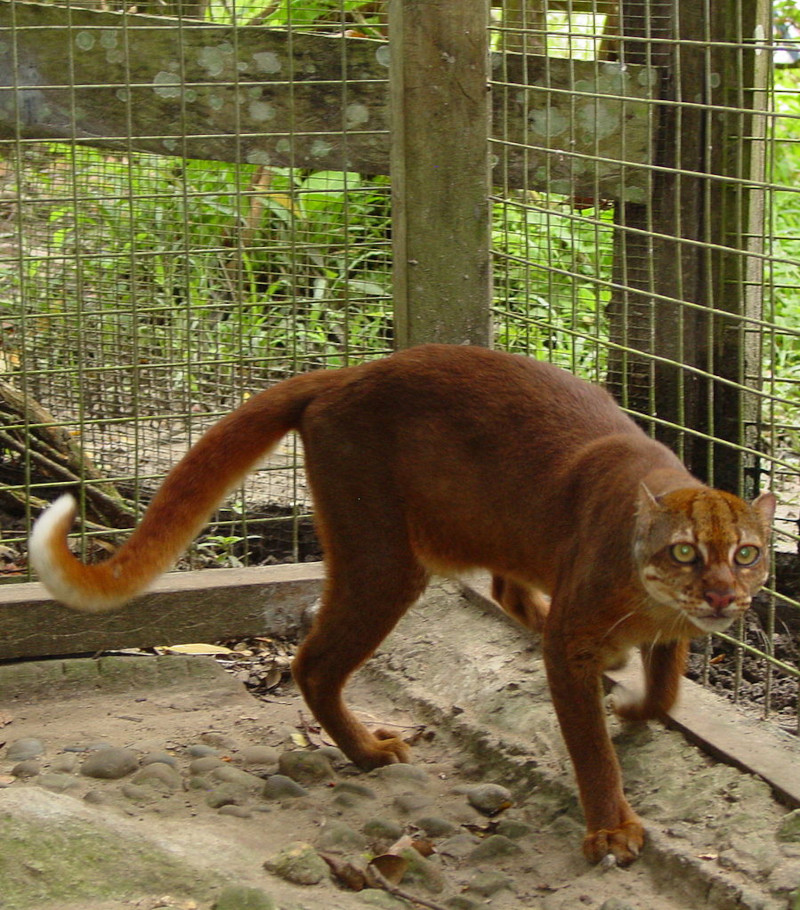Borneo Bay Cat Facts
- Most notably, the Borneo Bay Cat remains an extremely reclusive wildcat. No sightings occur outside of its native forest. It actually appears to be the Howard Hughes of the feline world.
- This remarkable mammal also forms an extremely rare species of wildcat.
- In 2002, the IUCN classified this species as Endangered. An exact count of its numbers remains unknown, but it remains rarely seen, and its area of habitation seems severely restricted.
- However, estimates place the total extant population of Borneo Bay Cat at fewer than 2,000. Given the restricted range, experts consider habitat loss (as usual) its primary threat.
- It seems to be highly specialized in its habitat requirements since no specimens have ever been seen outside the forest. We still know extremely little about the ecology or reproductive behavior of this amazing feline.
Related Articles
Borneo Bay Cat Physical Description
Since the discovery of the Borneo Bay Cat in 1874, the number of specimens studied firsthand only totals 12 individuals (imagine – only 12 in 141 years), so data on its size and weight can only be based on those scant few.
Based on the few examined to date, the species attains a maximum body length of about 26.4 in (67 cm), and a weight of roughly 8.8 lb (4 kg).
The tail of the Borneo Bay Cat averages nearly 16 in (40 cm) long. Its overall coloring remains a chestnut shade, and slightly lighter on the underbelly.
The ears develop somewhat rounded in shape (rather like those of a human). Typically, two dark stripes spread outward from the corner of each eye. The Borneo Bay Cat also usually displays a distinctive dark marking on the back of the head, which stays roughly M-shaped.
- Kingdom: Animalia
- Phylum: Chordata
- Class: Mammalia
- Order: Carnivora
- Family: Felidae
- Genus: Catopuma
- Species: C. badia
Borneo Bay Cat Distribution, Habitat, and Behavior
The Borneo Bay Cat also apparently only exists in two concentrations deep within the interior section of the island of Borneo, in Asia (perhaps wisely hiding from man). Evidence also indicates that while it resides solely within the forest, it will inhabit varied types of forest habitats.
Portions of the forest in which the animal has been spotted include swamp forests and highland forests, at altitudes of as much as 1,600 ft (500 m) above sea level. Further, the greatest concentration of either confirmed sightings or evidence of its presence occurred in the Gunung Mulu National Park.
All sightings of the Borneo Bay Cat have been in the vicinity of water, suggesting a rather close association (perhaps it actually likes to swim). Currently, we know nothing about where this species prefers to make its dens, however. Finally, evidence gained from camera traps placed in the region indicates that it primarily feeds as a nocturnal creature.
Species Sharing Its Range
Check out our other articles on 4 Remarkable Louisiana Reptiles, Visayan Leopard Cat, Mount Jade, Mountain Ebony, European Lobster, Hellbender Salamander, Lau Banded Iguana

